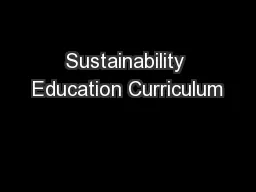

Middle School Program MAINE DEPARTMENT OF ENVIRONMENTAL PROTECTION Protecting Maines Air Land and Water What is Sustainability Sustainability Sustainability is about affording each generation equal opportunity to enjoy undiminished welfare by comparison to the welfare opportunities avai ID: 778494
Download The PPT/PDF document "Sustainability Education Curriculum" is the property of its rightful owner. Permission is granted to download and print the materials on this web site for personal, non-commercial use only, and to display it on your personal computer provided you do not modify the materials and that you retain all copyright notices contained in the materials. By downloading content from our website, you accept the terms of this agreement.
Slide1
Sustainability
Education CurriculumMiddle School Program
MAINE DEPARTMENT OF ENVIRONMENTAL PROTECTION
Protecting Maine’s Air, Land and Water
Slide2What is Sustainability?
Slide3Sustainability
Sustainability is about affording each generation equal opportunity to enjoy undiminished welfare, by comparison to the welfare opportunities available to earlier generations.
Slide4National Environmental Policy Act of 1969
Committed the United States to sustainability, declaring it a national policy “to create and maintain conditions under which humans and nature can exist in productive harmony, that permit fulfilling the social, economic and other requirements of present and future generations.”
Slide5EPA’s Strategic Plan (2018-2022)
To Protect Human Health and the Environment Goal 1 – Core Mission: Deliver real results to provide Americans with clean air, land, and water, and ensure chemical safety. Goal 2 – Cooperative Federalism: Rebalance the power between Washington and the states to create tangible environmental results for the American people.
Goal 3 – Rule of Law and Process: Administer the law, as Congress intended, to refocus the Agency on its statutory obligations under the law. (www.epa.gov)
Slide6EPA’s Strategic Plan
Energy EfficiencyGreen InfrastructureSustainable Materials ManagementSustainable Purchasing and Products
Slide7How do we measure sustainability?According to Bryan Norton…
Weak SustainabilityBased on the idea that what we owe the future is to avoid actions that will make them poorer than we are in terms of opportunities to achieve welfare equal to ours.
Each generation is required to maintain and pass on the economic capital they have inherited.No environmental goals should be given priority over other investments that have greater expectations of return in terms of capital accumulation.
Slide8How do we measure sustainability?According to Bryan Norton…
Strong sustainabilityIncorporates a category of social value - called “natural” capital.This capital is not created by humans.This capital is deemed essential to the well-being of the people of the future.
Requires the protection of natural capital to be passed to the next generation.
Slide9How do we measure sustainability?According to Bryan Norton…
What items have value to be passed to the next generation?This depends on who you ask… Financial assets?Technology?Labor?Natural resources?
Some people feel these items are all interchangeable.
Slide10How do we measure sustainability?According to Bryan Norton…
Some feel that because we do not know what people in the future will want, and because resources are intersubstitutable anyway all we can be expected to do is to avoid impoverishing the future by over-consuming and under-saving.
Slide11How do we measure sustainability?According to Bryan Norton…
Most mainstream economists and many philosophers prescribe to what Norton calls the “Grand Simplification”By stating we are ignorant of the future’s wants this wipes away any specific obligations beyond the next generation.As technologies change we can’t know what resources will be crucial to future generations…so we need not act.
Slide12Anthropocentric versus Non-anthropocentric Viewpoints
Anthropocentric – humans are considered to be the center, with others items put on earth for the humans use.
Slide13Anthropocentric versus Non-anthropocentric Viewpoints
Non-anthropocentricHumans are not considered the center Is it really possible to have a non-anthropocentric view if the viewer is human?
Slide14Sustainability
Does nature have intrinsic value?Does it matter if nature has intrinsic value?
Slide15QUICK REVIEW! Introduction to Sustainability (~2:00)
Slide16www.maine.gov/dep